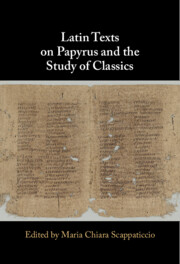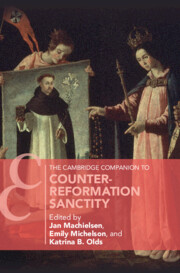Refine listing
Actions for selected content:
1295956 results in Books

Latin Texts on Papyrus and the Study of Classics
- Coming soon
-
- Expected online publication date:
- December 2025
- Print publication:
- 08 January 2026
-
- Book
- Export citation

Intracranial Abscess in Adults
- Coming soon
-
- Expected online publication date:
- December 2025
- Print publication:
- 31 December 2025
-
- Element
- Export citation

The Cambridge Companion to Counter-Reformation Sanctity
- Coming soon
-
- Expected online publication date:
- December 2025
- Print publication:
- 08 January 2026
-
- Book
- Export citation
Chapter 2 - Watery Prospects, 1815–1830
-
- Book:
- Irish Romanticism
- Published online:
- 27 November 2025
- Print publication:
- 11 December 2025, pp 75-115
-
- Chapter
- Export citation
References
-
- Book:
- Representing Relationships
- Published online:
- 21 November 2025
- Print publication:
- 11 December 2025, pp 365-415
-
- Chapter
- Export citation
Chapter 10 - God and the Eternal Truths I
- from Part II - God
-
- Book:
- The Philosophy of Antoine Arnauld
- Published online:
- 27 November 2025
- Print publication:
- 11 December 2025, pp 216-243
-
- Chapter
- Export citation
5 - Infrastructure and Maintenance Time
- from Part II - Architectural Autobiographies
-
- Book:
- Rebuilding Histories in the Roman World
- Published online:
- 23 November 2025
- Print publication:
- 11 December 2025, pp 207-273
-
- Chapter
- Export citation
Reviews
-
- Book:
- Kant and the Power of Perception
- Published online:
- 27 November 2025
- Print publication:
- 11 December 2025, pp ii-ii
-
- Chapter
- Export citation
Contents
-
- Book:
- Irish Romanticism
- Published online:
- 27 November 2025
- Print publication:
- 11 December 2025, pp v-v
-
- Chapter
- Export citation
1 - The Estates General
-
- Book:
- Empire of Fear
- Published online:
- 27 November 2025
- Print publication:
- 11 December 2025, pp 31-71
-
- Chapter
- Export citation
1 - The Dilemma of Army Cohesion
- from Part I - War in Florida
-
- Book:
- Protecting Women
- Published online:
- 27 November 2025
- Print publication:
- 11 December 2025, pp 34-69
-
- Chapter
- Export citation
4 - Overcoming Market Barriers to Unlock Health Capital for the Global South
- from Part I - Mobilizing Catalytic Finance
-
-
- Book:
- Catalytic Capital
- Published online:
- 27 November 2025
- Print publication:
- 11 December 2025, pp 88-112
-
- Chapter
-
- You have access
- Open access
- HTML
- Export citation
Chapter 1 - The Standpoint of the Perceiver
-
- Book:
- Kant and the Power of Perception
- Published online:
- 27 November 2025
- Print publication:
- 11 December 2025, pp 12-50
-
- Chapter
- Export citation
1 - Into the Mountains
-
- Book:
- The Conquest of the Mountains
- Published online:
- 14 November 2025
- Print publication:
- 11 December 2025, pp 13-45
-
- Chapter
- Export citation
Part II - Consubstantial Assimilation: The Conformation System of Communal Sharing
-
- Book:
- Representing Relationships
- Published online:
- 21 November 2025
- Print publication:
- 11 December 2025, pp 93-146
-
- Chapter
- Export citation
Industry, Trade and the State in Ptolemaic Egypt
- Coming soon
-
- Expected online publication date:
- December 2025
- Print publication:
- 31 January 2026
-
- Book
- Export citation
7 - Competing Narratives
-
- Book:
- The Conquest of the Mountains
- Published online:
- 14 November 2025
- Print publication:
- 11 December 2025, pp 177-207
-
- Chapter
- Export citation
Chapter 1 - Introduction
-
- Book:
- The Power of Peasant Consumers
- Published online:
- 27 November 2025
- Print publication:
- 11 December 2025, pp 1-34
-
- Chapter
- Export citation
Chapter 4 - Proscenium Subjects
-
- Book:
- Theatre as Technology
- Published online:
- 27 November 2025
- Print publication:
- 11 December 2025, pp 118-160
-
- Chapter
- Export citation
21 - Re-Imagining Place (1940–1990)
-
-
- Book:
- The Cambridge History of Australian Poetry
- Published online:
- 19 November 2025
- Print publication:
- 11 December 2025, pp 400-419
-
- Chapter
- Export citation
